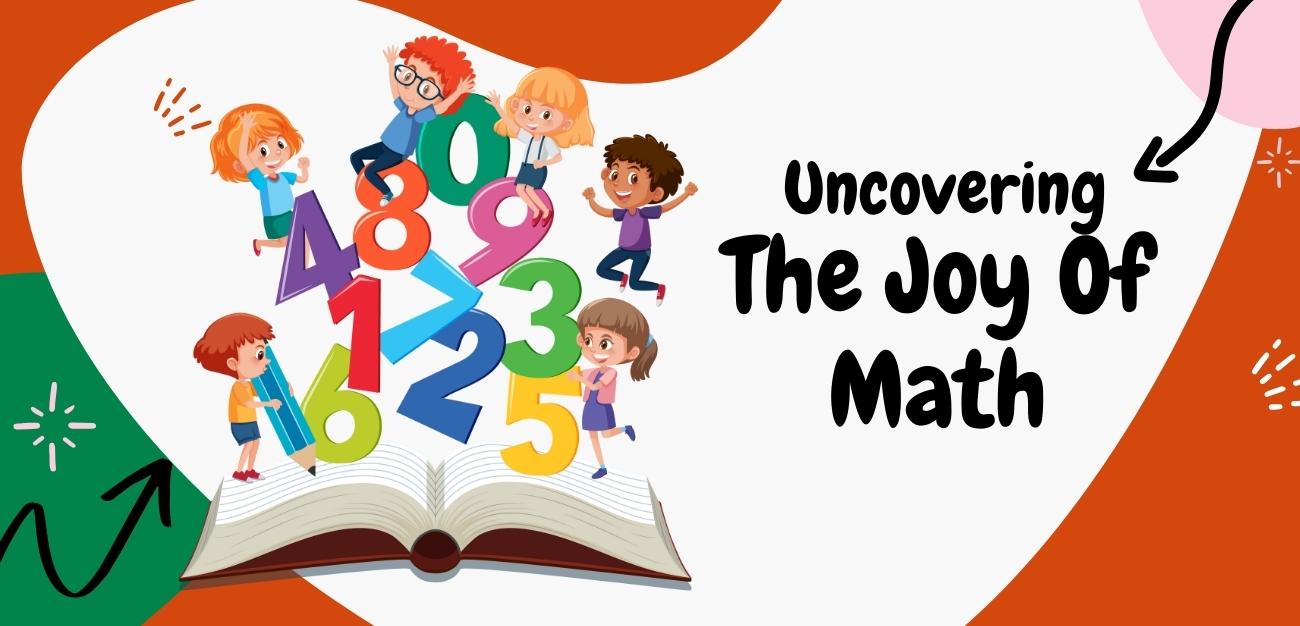Welcome to “Uncovering The Joy of Math.” This blog is made especially for you, a parent seeking techniques to cultivate a love for mathematics in your child. Mathematics can be intimidating, and it’s not uncommon for adults to grapple with math-related anxiety. Sadly, this fear can unintentionally rub off on our children. The great news is, it doesn’t have to be this way. This blog is your guide to overcoming that fear, fostering a brighter relationship between your kids and math, and ultimately, uncloaking the fulfilling thrill of understanding numbers.
“Mathematics is not about numbers, equations, computations or algorithms. It is about understanding.” – William Paul Thurston, American Mathmetician.
Remember, the goal isn’t to turn your child into the next Pythagoras. The main aim is to nurture their curiosity, help them appreciate the beauty of patterns, logic, and the incredible symphony of numbers. We also want you, the parent, to learn how to teach math effectively so your and your child don’t have to suffer with frustration or anxiety. Let’s start this fascinating journey into the joy of math together!
Breaking The Cycle: Overcoming Math Anxiety As A Parent
Before finding joy in mathematics, we must overcome our anxiety with math. It’s all too easy to see your own struggles with math reflected in your child’s homework. However, your fears don’t have to become their fears. By acknowledging and overcoming your own math anxiety, you can help foster a love of math in your child. Here are some strategies to consider:
- Change Your Mindset: First and foremost, it’s important to shift your perspective. Just because you struggled with math doesn’t mean your children will. Remember, everyone has the capability to learn and excel in math. It’s not a talent; it’s a skill that can be honed with practice.
- Start Early and Make It Fun: Incorporate math into daily activities. Use baking, shopping or even sports to showcase how math is integral to everyday life. Turning math into practical, engaging activities can make it more appealing.
- Encourage a Growth Mindset: It’s okay to make mistakes. They are an integral part of the learning process. Help your child have a healthy attitude towards failure, reinforcing that mistakes are opportunities for growth and improvement.
- Focus on Understanding: Avoid putting an exclusive focus on getting the ‘right’ answer. The journey and thought process towards the solution is far more significant than the destination itself. Encourage your child to understand concepts rather than memorize them.
Making these small adjustments in your approach can make a big difference. Math doesn’t have to be synonymous with stress and confusion. With the right support and encouragement and math learning techniques, it can turn into an exciting exploration of numbers and patterns.
Remember: Your attitude towards math can significantly affect your child’s experience. Be the role model they need. Embrace the joy of learning math and inspire your child to do the same.
From Drudgery To Delight: Making Math Engaging
Understanding that math can be engaging and exciting is the first step in instilling the same sentiment in your child. In fact, the beauty of math lies in its application and versatility. There’s much more to it than reciting multiplication tables or solving repetitive problems. Here’s what you can do:
- Design Math Games: Who says math can’t be fun? There are countless math games available that encourage strategic thinking, logical reasoning, and problem-solving. Games like Sudoku, Chess, Tangram, and even certain video games help children develop mathematical skills in entertaining ways.
- Make It Practical: Math is everywhere. Make your child see this by incorporating math into daily activities. Be it measuring ingredients for a recipe, estimating the cost of groceries, or calculating the time it takes to get to soccer practice, there are countless ways to bring math into day-to-day conversations.
- Visualize It: Sometimes, graphical representation aids in understanding complex mathematical concepts. Use images, diagrams, and charts to explain patterns, fractions, or geometrical shapes. You could even make use of digital tools that offer interactive visuals.
- Connect It To Their Interests: If your child loves sports, use statistics from their favorite game to explain mathematical concepts. If they’re into art, explore geometry and patterns through drawing. Linking math with their interests makes learning less about memorizing and more about understanding.
Remember, the goal is not to turn every activity into a math lesson but to demonstrate math’s relevancy in our everyday lives. Math, like any other subject, is a skill to be mastered, not dreaded. As a parent, if you approach math positively, your child will too.
Creating A Supportive Learning Environment
To nurture a love of mathematics within your child, it is essential to create a supportive and engaging environment for learning. A home where it’s safe, fun and rewarding to explore math operations can significantly lessen the impact of any inherited math anxiety.
Here are some simple yet effective strategies:
- De-stress the Space: It’s essential to keep stressful stimuli out of your child’s learning space. Comfortable seating, ample lighting, and a quiet atmosphere can all contribute to a relaxed environment where your child can focus exclusively on math. Consider soft background music or white noise to enhance the calm.
- Simplify and Personalize: Removing distractions and personalizing your child’s study area with things they love will not only make the space inviting but will also foster a positive association with maths learning.
- Provide Useful Tools: Ensure your child has access to the necessary resources such as stationery, workbooks, or math learning apps. Making these tools readily accessible can help your child feel prepared and empowered to tackle their math problems.
- Set a Schedule: Routines can ease anxiety. Establishing a consistent math study time helps to create a sense of certainty and reliability. Make it flexible though, so it doesn’t add pressure.
You could also use real-life instances to incorporate math into your child’s daily routine. This tactic doesn’t only make math relevant but also helps your child see math as a less intimidating, more everyday concept.
Math Around Us
The world around us is full of numbers, shapes, patterns, and equations. Hence, showing your kids how math is integrated into our daily life stimulates their interest and emphasizes its importance. Here are a few simple ways you can bring math to life:
- Shopping: Use shopping trips as an opportunity to teach them about money management, price comparison, calculating discounts, and budgeting. This can also introduce them to the concepts of inflation and recession in due course.
- Cooking: Preparing meals together can be a good opportunity to understand fractions, weights, measures and proportions. And chances are they will love the edible results of their math homework!
- Outdoor Activities: Nature walks, sports, or even the playground can provide great instances to explore geometry, counting, measurement, and problem-solving.
In the end, inspiring a love for math in your child will depend on your ability to make it cozy, personal, and relevant. Ultimately, your goal should be to create the kind of environment that will make your child genuinely want to engage with math rather than seeing it as an obligation.
Exploring The Joy Of Problem-Solving
Now, let’s get into finding the joy in mathematics! When we think about math, we often associate it with problems that require solving. This might seem daunting at first, but it’s important to realize that problem-solving is at the heart of many fun activities we already enjoy, such as puzzles and games. By framing math problems as fun challenges to tackle, we can help foster a love for math in our children.
Discovering the Beauty of Patterns and Sequences
Patterns and sequences are everywhere in math, and they can be a wonderful source of joy and wonder to those who approach them with the right mindset. They are integral to the harmonious structure of mathematics, paving the way for a deeper understanding of complex concepts like multiplication, division and even calculus. In many ways, patterns and sequences are the poetry of mathematics – a poetry that transcends numbers and symbols, reaching into reality itself.
- Real-Life Patterns: Our lives are filled with patterns, from the rising and setting of the sun, the change of seasons, to the daily routines we follow. Encourage your child to spot these patterns in their environment. They’ll soon realize that math is not just confined to textbooks, but it’s a fundamental part of the world.
- Sequences: Effective manipulation of sequences—whether geometric or arithmetic—doesn’t just develop computing skills in children; it also enhances their logical reasoning and deduction abilities.
The real magic happens when kids start creating their OWN sequences. This is where the joy of exploration and discovery truly lights up a child’s learning experience. It tends to make learning math more of a delightful game rather than a high-pressure task.
For one, creating sequences can be a fun activity. Maybe it’s as simple as coming up with a sequence of even numbers, or maybe it’s coming up with a Fibonacci-like sequence based on their favourite numbers. Here’s another idea: encourage your child to create visual patterns using shapes, colours, and math operations. These exercises are not only creative and fun, but they also offer great mental workout.
Approaching math with a sense of play and curiosity is the key to instilling a love for the subject in your child. Rather than emphasizing performance and grades, help them appreciate the beauty and utility of math, and the joy it brings.
So dear parents, as we conclude, we understand that overcoming our math anxiety might seem like a daunting challenge, but remember, it’s indeed achievable and worth the effort. By making math engaging, creating a supportive learning environment, highlighting the magic of problem-solving, and revealing the enchanting world of patterns and sequences, we can surely ignite a lifelong passion for math in our children. Let’s pass down an exhilarating adventure of discovery and learning that opens their minds to the infinite possibilities that math brings. After all, every child deserves to experience the true joy of math!
Sign up for our bulletin to learn more about spreading the joy of math to your child and learn techniques to help with their math education.





